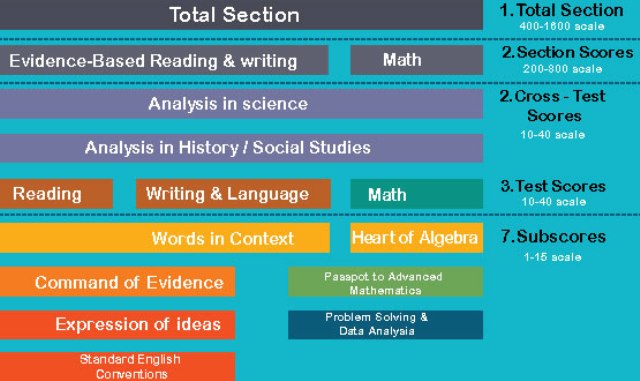Test Format

The SAT Test Format is divided into 4 sections namely.
Reading
52 Questions to be answered in 65 minutes.
Writing and Language
44 Questions to be answered in 35 minutes.
Math
Math is further classified in two sections,
Section 1 : 20 Questions to be answered in 25 minutes (No calculator allowed)
Section 2 : 38 Questions to be answered in 55 minutes (Calculator allowed)
Optional Essay
Write an Essay on 1 topic only, in 50 mins.
The Total duration of the entire Test Format is 3 Hours 45 minutes.
Section

JME offers one of the most intensive, comprehensive, affordable and value-for-money training services for SAT in India. One of the most salient features of training at JME is a very strong focus on building the foundation of Mathematics and coupling the same with rigorous practice.
The focus on Verbal part revolves around making students work with different types of questions, guiding them with approach, reasoning and giving them sufficient practice so that they are armed with tools to answer any type of question.
The reading section of the test measures your ability to understand what you read and to recognize basic conversations of standard written English.
The Math section of the SAT exam measures your ability to reason to mathematicelly, solve Math problems and interpret graphic data.
The writing section of the test measures your knowledge of grammar and conversations of standard and written expression.
Essay - The optional essay section measures your ability to think critically and communicate aruplex ideas through writing.
Scoring

Total Score Sum of the two sections scores 400-1600 Section Scores Evidence Based Reading & Writing & Math 200-600. Test Scores Reading, Writing & Language & Math 10-40 SAT Essay Scores. The SAT Essay is Reading, Analysis & Writing.
Cross Test Scores Analysis in History/Social Studies & Analysis in Science. Based on selected questions in the Reading, Writing & Language & Math Tests. These scores are showing how well you use your skills to analyze texts & solve problems in thers subject areas 10-40.
Subscores Reading, Analysis & Language : Command of Evidence & Words in Context, Writing & Language : Expression of Ideas & Standard English Conventions, Math, Heart of Algebra, Problem Solving & Data Analysis & Passport to Advanced Math 1-15.
Good Score 1250+/1600
Training

Salient Features of SAT training @ JME
• 100 hours of intensive and comprehensive training.
• Maximum 10-15 students per batch, making the sessions personalized.
• Mathematics for MBA by RS Agarwal, SAT Official Guide and Princeton SAT issued as courseware.
• Teaching pedagogy involving a very strong focus on building fundamentals in Math, guiding students with approach towards different question types, helping students build reasoning skills and giving sufficient practice.
• Qualified, experienced & trained faculties.
• 20 full-length mock tests.
• Well stocked library.
• Availability of Weekdays (Tuesday to Friday, 2 hours per day) and Weekend Batches (Saturday and Sunday, 4 hours per day) under Regular Mode.
• Availability of Fast Track Mode (Tuesday to Sunday, 4 hours per day) for people who want to complete the course at the earliest.
Miscellaneous

Score Validity : 5 years
Registration Mode : Mail / Online
Mode of payment : Credit card / Pay Pal
Test Fee with Essay : $ 113.50
Test Fee without Essay : $ 96.50
Nature of Test : Paper Based Test
Score Reporting time : Approximately 17 Calendar Days Extra
Score Reporting Fee : $ 12
Official Website : www.collegeboard.org
Rescheduling Fee : $ 29
Test Administration Frequency : 4 times a year
Test Repetition policy : No restrictions
Late Fee : $ 29 (after missing the regular deadline)
FAQ

1. What is the SAT?
The SAT is an exam administered by The College Board to test college and career readiness. It is primarily used for the purpose of gaining admission to college. The SAT is widely considered to be the single most important test you take in high school.
2. What is the difference between SAT and ACT?
One major difference between both the exams is that ACT includes a whole section on Science which is not present in the SAT. Students from Science background can showcase their skills related to Science subject through an ACT.
There is a key structural difference between both the exams like during the ACT exam, the applicant can use a calculator while in the SAT the applicants need not use the calculator as it comprises of a short ‘no calculator subsection’.
3. I live outside of the United States. Can I take the 2016 SAT overseas?
Absolutely. The test has long been offered in numerous other countries, and this will not change. See the College Board website for specific policies by country.
4. What is the PSAT? Why & When should I take the PSAT? How is the PSAT different from the SAT?
Think of the PSAT as a baby brother of the SAT. It serves as a practice test to show you what the SAT® is like. For most students, the PSAT serves as a good wake up call to start thinking about college application process. The PSAT is administered in October. While you can take the PSAT as a Sophomore, you should definitely take it as a Junior as your PSAT score could qualify you to enter National Merit Scholarship programs. Learn more about why studying for the PSAT can be benefitial.
